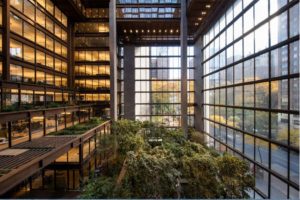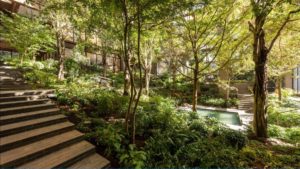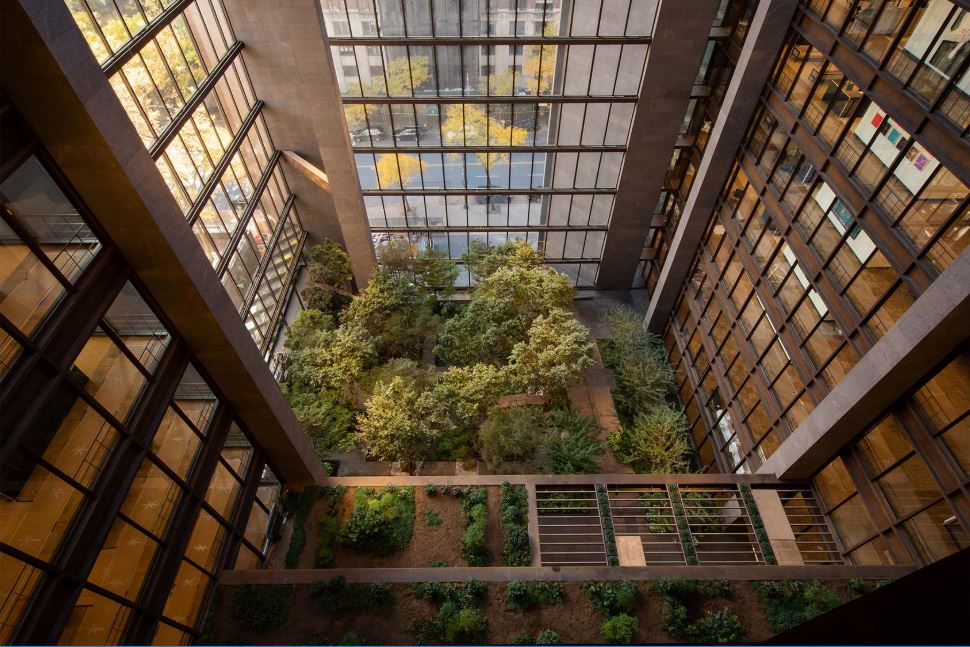On December 4, 2018 in New York City, the giant design-build firm, Gensler—in partnership with the Ford Foundation—announce the reopening of the foundation’s landmark headquarters, and its transformation into the Ford Foundation Center for Social Justice.
This major restoration and renewal maintains and enhances the building’s original character while also significantly introducing an increase in transparency and accessibility throughout the space.
 Gensler undertook this redesign with an emphasis on architectural stewardship and an eye to the foundation’s mission for the 21st century — to promote the inherent dignity of all people. For the renewal the design team sought to make meaningful program changes while maintaining both the design intent as well as the patina of the original project architecture.
Gensler undertook this redesign with an emphasis on architectural stewardship and an eye to the foundation’s mission for the 21st century — to promote the inherent dignity of all people. For the renewal the design team sought to make meaningful program changes while maintaining both the design intent as well as the patina of the original project architecture.
The renewal also brings the iconic building into alignment with New York City safety code and New York City Landmarks Preservation Commission requirements, with the goal of creating a more inclusive community experience for employees, tenants, and the general public. The newly reintroduced Ford Foundation Center for Social Justice is targeting LEED Platinum certification.
“Over the past four years, we’ve worked closely with Ford Foundation’s team to completely rethink approaching a renovation project on this scale,” said Robin Klehr Avia, Gensler Project Principal. “We knew that any changes we made to the building would need to both support and enhance the foundation’s values. The project leverages Gensler’s technical expertise in sustainable architecture for collaborative workplace interiors, as well as branding and graphic design, to express the Ford Foundation’s story — past, present, and future.”
Creating a More Accessible Building:
 Completed in 1968 by Kevin Roche John Dinkeloo and Associates, the foundation’s global headquarters—at 51, one of New York City’s youngest architectural landmarks—was a deliberate and nuanced response to the organization’s founding mission: to support education and charitable purposes for the advancement of human welfare.
Completed in 1968 by Kevin Roche John Dinkeloo and Associates, the foundation’s global headquarters—at 51, one of New York City’s youngest architectural landmarks—was a deliberate and nuanced response to the organization’s founding mission: to support education and charitable purposes for the advancement of human welfare.
Gensler’s updated design features increased accessibility, open plan workplaces, expanded convening spaces, improved technical systems, complete restoration and planting of the sprawling indoor garden, and a forthcoming art gallery (opening March 2019). These key changes speak to Gensler’s belief that human experience is a key component in developing a healthy and connected workplace in today’s rapidly changing world.
Highlights of the redesign include:
- A move to open workspaces that has enabled the incorporation of 50% more convening and collaborative areas, increased daylight, and views of the central atrium and garden available on every floor.
- Methodical un-doing and then re-doing of the building’s infrastructure to bring all systems up to code — including mechanical, electrical, plumbing, sprinkler and fire alarm systems — without sacrificing the building’s modernist aesthetics.
- Increased accessibility beyond local ADA code requirements with restored textured brick pathways and expanded entrances to the atrium that has improved wheelchair access to the garden by 50%, a new vehicle drop-off point, and an accessible ramp on 43rd Street.
- Restored core-ten steel framing in select locations within the building to address 50 years of weathering.
- A refresh of the garden — spanning a third of an acre in size — that adheres closely to the lush landscape originally designed by landscape architect Dan Kiley and features a wheelchair lift and a touch-and-smell garden with fragrant and tactile experiences for all.
- To meet the foundation’s commitment to respect the original building, Gensler led an expansive effort to restore or refurbish over 1,500 pieces of furniture and original accents such as carpet, lighting, millwork, and bronze and leather details to their original finish.
Conveying the Voice of the Foundation:
Gensler has implemented a full signage program, directory, and wayfinding strategy to reflect the building’s clean architecture and welcome a diverse new community to the building. The brand design highlights the foundation’s program, which includes an extensive art collection; ensures that the mission of the foundation is fully communicated; and that new levels of inclusivity, diversity, and stewardship are integrated throughout the space.
Key elements of the brand design include:
- A coded signage program, integrated with braille, that supports a seamless journey for all persons.
- Totems in the garden that explain the foundation’s central story and provide information on various plants.
- Powerful imagery and text that support the foundation narrative, including meeting rooms dedicated to social justice visionaries and their individual stories.
The Ford Foundation’s Mission is on Display in a New Art Gallery and Program:
The Ford Foundation’s world-class art collection and commitment to contemporary art was also a central focus of Gensler’s renovation. By removing a portion of the building’s second floor concrete slab, Gensler created a new double-height art gallery that will host an exhibition program grounded in the foundation’s mission. Featuring 20-foot ceilings and state-of-the art lighting, the gallery will be capable of museum-quality presentations led by an in-house curator.
The brand program will also incorporate site-specific installations and murals that will be visible to the community through the atrium and common areas.
The Ford Foundation is an independent, nonprofit grant-making organization. For more than 80 years it has worked with courageous people on the frontlines of social change worldwide, guided by its mission to strengthen democratic values, reduce poverty and injustice, promote international cooperation, and advance human achievement. With headquarters in New York, the foundation has offices in Latin America, Africa, the Middle East, and Asia.
There will, of course, be those who wonder if the money spent on this renovation and art show might not have achieved more social justice if spent in other ways. But this is New York City, so it’s possible that the Ford Foundation was going for a more ironic, aristocratic approach. If so, well done!
All images courtesy of Gensler.

